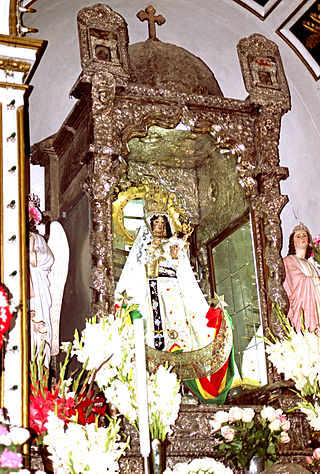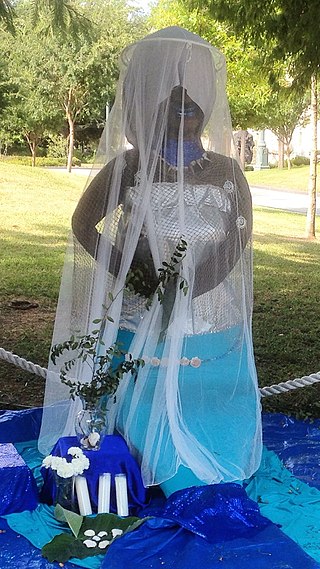First logo
From its founding until 1574, the university's first official seal featured an icon of the "Virgen del Rosario" ( Virgin of the Rosary ), patron saint of the Dominican friars; at the right was a representation of the Pacific Ocean and on the bottom a lime (fruit) (that is, the fruit, which in Spanish is una lima, hence Lima, Peru).
The logo was approved by King Charles I of Spain in 1551. By the late 1570s and after a papal bull of Pope Pius V, the seal was modified, replacing the icon of Virgen del Rosario with Saint Mark. It is uncertain which colors were used on this seal, because documents in the 16th century were only black-and-white paper prints. It was not until 1929 when the colors— blue for the ocean, black or brown for the saint's icon, a light blue background, and silver for columns —became popular.
This logo was the longest-enduring symbol of the university: it was used for almost four and a half centuries, until the late 1980s, when it was improved for the second generation logo.

The tree of life is a fundamental archetype in many of the world's mythological, religious, and philosophical traditions. It is closely related to the concept of the sacred tree. The concept of the tree of life may have originated in Central Asia, and absorbed by other cultures, such as Scandinavian mythology and Altai shamanism.

The swastika is an ancient religious and cultural symbol, predominantly in various Eurasian, as well as some African and American cultures, now also widely recognized for its appropriation by the Nazi Party and by neo-Nazis. It continues to be used as a symbol of divinity and spirituality in Indian religions, including Hinduism, Buddhism, and Jainism. It generally takes the form of a cross, the arms of which are of equal length and perpendicular to the adjacent arms, each bent midway at a right angle.

A logo is a graphic mark, emblem, or symbol used to aid and promote public identification and recognition. It may be of an abstract or figurative design or include the text of the name it represents as in a wordmark.

An emblem is an abstract or representational pictorial image that represents a concept, like a moral truth, or an allegory, or a person, like a monarch or saint.

The flag of Barbados was designed by Grantley W. Prescod and was officially adopted to represent the nation of Barbados at midnight on 30 November 1966, the day the country gained independence. The flag was chosen as part of a nationwide open contest held by the government, with Prescod's design being selected as the winner of a field of over one thousand entries. The flag is a triband design, with the outermost stripes coloured ultramarine, to represent the sea and the sky, and the middle stripe coloured gold, to represent the sand. Within the middle band is displayed the head of a trident. This trident is meant to represent the trident of Poseidon, visible in Barbados's colonial coat of arms, and the fact that it is broken is meant to represent the breaking of colonial rule in Barbados and independence from the British Empire.

A solar symbol is a symbol representing the Sun. Common solar symbols include circles, crosses, and spirals. In religious iconography, personifications of the Sun or solar attributes are often indicated by means of a halo or a radiate crown.

The flag of the state of Maryland is the 17th-century heraldic banner of arms of Cecil, 2nd Baron Baltimore. It consists of the arms of his father George, 1st Baron Baltimore (1579–1632), quartered with those of his grandmother, heiress of the Crossland family. The flag was officially adopted by the General Assembly of Maryland in 1904.

The city of Kraków uses a coat of arms, a seal, official colors, a flag, and a banner as its official symbols. Additionally, a number of semi-official and unofficial symbols of the city are also used.

The flags of New York City include the flag of New York City, the respective flags of the boroughs of The Bronx, Brooklyn, Manhattan, Queens, and Staten Island, and flags of certain city departments. The city flag is a vertical tricolor in blue, white, and orange and charged in the center bar with the seal of New York City in blue. The tricolor design is derived from the flag of the Dutch Republic—the Prince's Flag—as used in New Amsterdam in 1625.

Our Lady of the Porta Vaga is a Roman Catholic Marian title of the Blessed Virgin Mary associated with a venerated Marian painting.

Superman shield, also known as the Superman logo or the Superman symbol, is the iconic emblem for the fictional DC Comics superhero Superman. As a representation of one of the first superheroes, it served as a template for character design decades after Superman's first appearance. The tradition of wearing a representative symbol on the chest was followed by many subsequent superheroes, including Batman, Green Lantern, the Flash, Wonder Woman, Hawkman, and many others.

A baseball uniform is a type of uniform worn by baseball players, coaches and managers. Most baseball uniforms have the names and uniform numbers of players who wear them, usually on the backs of the uniforms to distinguish players from each other. Baseball shirts (jerseys), pants, shoes, socks, caps, and gloves are parts of baseball uniforms. Most uniforms have different logos and colors to aid players, officials, and spectators in distinguishing the two teams from each other and the officials.

Seton Hill Historic District is a historic district in Baltimore, Maryland. It was listed on the National Register of Historic Places in 1975.

The Virgin of Candelaria or Our Lady of Candle, popularly called La Morenita, celebrates the Virgin Mary on the island of Tenerife, one of the Canary Islands (Spain). The center of worship is located in the city of Candelaria in Tenerife. She is depicted as a Black Madonna. The "Royal Basilica Marian Shrine of Our Lady of Candelaria" is considered the main church dedicated to the Virgin Mary in the Canary Islands and she is the patron saint of the Canary Islands. Her feast is celebrated on February 2 and August 15, the patronal feast of the Canary Islands.

The Roman Catholic Diocese of Malolos is a Roman Rite Diocese of the Latin Church of the Catholic Church in the Philippine, encompassing the whole Province of Bulacan and Valenzuela City in Metropolitan Manila and is a suffragan to the Archdiocese of Manila. The mother church of the Diocese is the Cathedral-Basilica of the Immaculate Conception located in Malolos City, Bulacan. The Blessed Virgin Mary, under the title of Immaculate Conception is the principal patroness of the diocese.

The Virgen de Copacabana is the patron saint of Bolivia. She is venerated in Bolivia during her feast day of 2 February, the day of the Purification of Mary, or feast of the Virgen de la Candelaria. She is also venerated on 5 August with her own liturgy and popular celebration.

Our Lady of the Most Holy Rosary, Queen of the Caracol, known locally as Mahal na Birhen ng Santo Rosaryo, Reyna ng Karakol or Nuestra Señora Virgen del Santissimo Rosario, Reina de Caracol, is the patroness of the Municipality of Rosario, formerly known as Salinas, in Cavite province, Philippines.

Yemọja is a major water spirit from the Yoruba religion. She is the mother of all Orishas. She is an orisha, in this case patron spirit of rivers, particularly the Ogun River in Nigeria, and oceans in Cuban and Brazilian orisa religions. She is often syncretized with either Our Lady of Regla in the Afro-Cuban diaspora or various other Virgin Mary figures of the Catholic Church, a practice that emerged during the era of the Trans-Atlantic slave trade. Yemọja is said to be motherly and strongly protective, and to care deeply for all her children, comforting them and cleansing them of sorrow. She is said to be able to cure infertility in women, and cowrie shells represent her wealth. She does not easily lose her temper, but when angered she can be quite destructive and violent, as the flood waters of turbulent rivers.

The Panagia Agiosoritissa or Hagiosoritissa is the name for a type of Marian icon, showing Mary without child, slightly from the side with both hands raised in prayer. The type is known in Latin as Maria Advocata.

The coat of arms of the University of Notre Dame is the assumed heraldic achievement of the University of Notre Dame. It was designed by noted American heraldrist Pierre de Chaignon la Rose in 1931.























